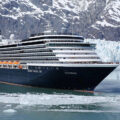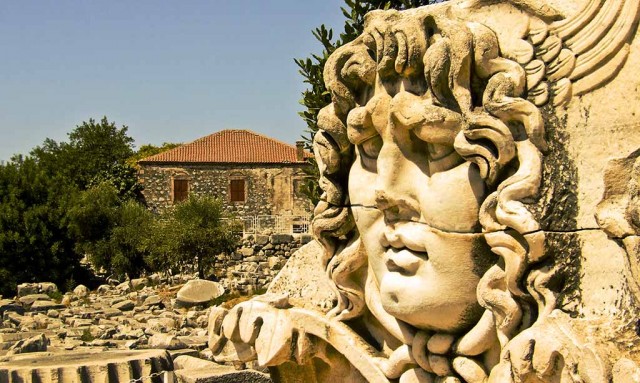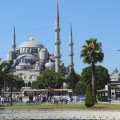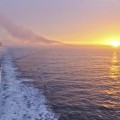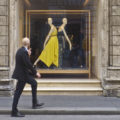
Godfather, how much of what I’ve seen in the films is real?
What they show about the old country, where the Family came from, does it really exist?
On a port call of Holland America Line’s ship Noordam at Messina in Sicily, I was about to learn more than perhaps I should have about They Who Should Not be Named while following the footsteps of The Godfather.
The trail took us up precarious mountain roads to places that remain tiny and unchanged because they are so remote that the trend has been for their inhabitants to emigrate to cities or overseas. Holland America’s tour reversed the trend, bringing a busload of passengers from around the world to visit the scenes the mythical Corleone Family visited in Italy the trio of movies by Francis Ford Coppola.
Our guide is Maria Theresa, who was a small girl when the Italian scenes in the second and third epics were filmed in the hill towns near Messina in the 1970s. She knows better than most that — like everything Hollywood does — there’s a lot of artifice in what you see on the big screen, but there’s a lot of truth as well. And fortunately, the views of rural Sicily that showed up in the films are very real and in fact, still much the same as they were three decades ago.
Corleone
Yes, there is actually a place called Corleone, the namesake of the central character in The Godfather, Don Corleone, played by Marlon Brando and Robert De Niro. But we’re not visiting there today, because it wasn’t actually used as a location. The town near Palermo, on the west coast of Sicily, does have a Mafia connection, but the film makers decided it was too modern and developed. Instead, they chose quaint hill towns near Taormina, within view of Mount Etna.

Part of the fun of this tour is the ride there. From Noordam, that was docked in Messina, we hit the coastal highway that goes through dozens of tunnels blasted through mountains that for centuries had been nearly impenetrable barriers. The towns are built on cliffs high up the slopes, accessible only by highways with dozens of hairpin turns.
“Don’t look down if you fear heights,” Maria warns. I also feared for drivers of cars coming down hill meeting a bus that is as wide as the road. Several times we had to stop and back up to get enough clearance to make it around a corner. It didn’t inspire confidence to see the shrines and flowers left along parts of the road where railings have been bent out of shape by vehicles going over the edge. But our driver is a pro and it’s a gorgeous drive, with the colors of pomegranates, limes and oranges hanging on trees along the steep terraced mountainside as we zig and zag our way to our first stop.
Savoca
The first stop, Savoca, is a village of 800 perched on a precarious cliff. The Bar Vitelli is where Michael Corleone (played by Al Pacino) discussed his proposed marriage to Apollonia (played by Simonetta Stefanelli) with her father, the owner of the bar, aptly named Vitelli in the film.

The somewhat ramshackle bar remains much is as it appears in movie. In part, that’s because the owners have turned it into a shrine to the filming, including one table by the arched doorway that’s set with a sawn-off shotgun — which was a favorite Mafia gun — and a couple of berets, for patrons to wear for souvenir photos. Inside, the panelled bar is decorated with photos, press cuttings and mementos from the making of the film. But it’s still a working bar, that makes killer espresso and heavenly home made lemon ice known as granita.
Our group then walked up the hill to the Chiesa Santa Lucia, parts of which date from the 1400s, where the scene of the wedding between Michael and Appollonia was filmed. It seemed appropriate for a gang that depends on a code of ‘don’t talk and don’t let anyone know you saw anything’ that Santa Lucia is the patron saint of the blind.
Forza d’Agro
Up another steep corkscrew trail is the village of Forza d’Agro, which features in the second and third films. The square was a stand-in for the main square of the town of Corleone. Today there’s even an Il Padrone restaurant, with the Godfather profile of Marlon Brando as its logo.
The town was where Robert DeNiro, playing a young Vito Corleone, was chased in a gun battle after stabbing a rival who had ordered his father killed.

On the main street is the church of Maria Annunziata Assunta, that set the mood of old Sicily. Built in the 15th century and rebuilt after an earthquake in 1648, its interior includes a famous wooden cross from the 12th century. The bells and the rice on the steps from a recent wedding set a happy mood, but inside there are creepy reminders of inevitability of death in the glass panels in the floors that cover burial crypts.

Further up the hill is the Chiesa Santissima Trinita, where a wedding party for Michael and Applllonia was filmed. In a flower bed, I found a discarded Champagne flute. So the parties still go on, even though the main activity in the town seemed to be old men sitting around tables and reminiscing while playing card games.
On the drive home, Maria broke her code of silence to give an interesting explanation of how the M*** – oh, all right the Mafia – got their start. About a century ago, wealthy land owners were bristling against efforts by the government to cut their feudal entitlements. They hired thugs to rough up anyone who tried to tell them what to do. It worked at first, but the hired hands decided to organize and take a bigger share of the action and they became “a cancer,” she said.
“We are trying to defeat the Mafia by teaching trust in government and confiscating the proceeds of crime,” she said. And the Godfather will be a piece of history.

